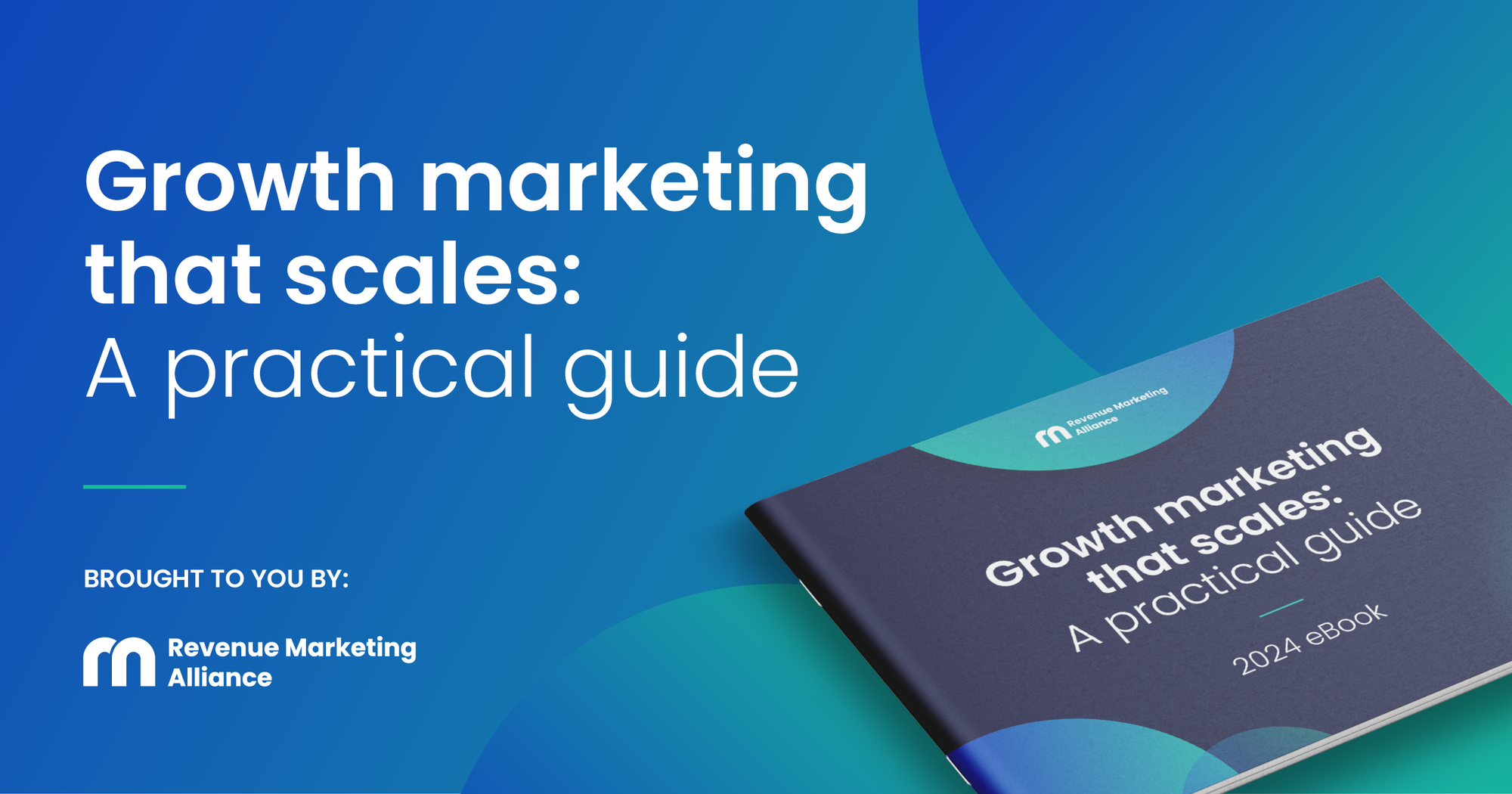Utilizing data-driven strategies in growth marketing not only eliminates guesswork but allows you to make informed decisions that propel your campaigns forward.
Everything is measurable, trackable, and can be calculated. It gives you the power to make decisions based on real, tangible information, streamline your campaigns, and stay ahead of the competition.
In this article, we’ll discuss how you can use data to optimize your growth marketing funnel, transforming every step – from initial awareness to the pivotal moments of customer referral.
Stages of the growth marketing funnel: A quick rundown
Awareness: This is where prospects will become aware of your brand after you showcase your products and services via the likes of paid campaigns, social media campaigns, and optimized content.
Acquisition: Here’s where people start to show interest and you’ll begin acquiring new customers. Your data should give you an understanding of what’s going well and what isn’t, and everything you do can be adjusted to produce better results.
Activation: After you’ve started getting new customers, the next step is to ensure they actually start using your product or service or engaging with your brand, so make sure your onboarding strategy is top-tier.
Retention: Now you’ve got your customers, you don’t want to lose them! Advancing your retention rates means improved growth, so utilize your customer data to glean great insights into customer behavior and design awesome outreach programs that drive positive customer experiences.
Revenue: At the revenue stage, customers contribute to your business's income. The objective here is to maximize revenue per customer and stimulate overall business growth.
Referral: Satisfied customers will shout about how great you are – we all know the power of word-of-mouth marketing. You can encore this by creating referral programs for your wonderful customers.
Data-driven decision making
Relying on gut instincts alone is no longer enough. To truly thrive, you need to embrace data as the driving force behind your marketing decisions.
When you collect and analyze relevant data, as we’ve touched on in the growth marketing funnel above, you'll gain valuable insights into your target audience's behavior, preferences, and pain points.

This information will empower you to make better-informed choices, allocate resources effectively, and craft campaigns that resonate with your customers.
But where do you start?
Begin by identifying the key metrics that matter most to your business, such as website traffic, conversion rates, customer acquisition costs, and CLV. Implement reliable tracking and analytics tools to capture this data accurately.
Once you have the data, leverage data visualization techniques to uncover patterns, trends, and opportunities for optimization.
“The buck doesn’t stop with the statistics. Develop a culture of continuous learning and experimentation. Encourage your team to question assumptions, test hypotheses, and iterate based on the insights provided by the data.
“We all love data, it validates and ratifies and it guides. It also lies to and fools us! By that I mean, data and data points need context especially when you are engaging actual humans…
“So data might indicate something specific but very often that indication will be in isolation or finite, it’s difficult to build a data story that shows the connected impact of multiple decisions (that’s why we call it AB or ABC testing – because any more variants begin to dilute the conclusions you can draw).
“So apply context and a wider perspective without getting blinkered, e.g. be aware that you changed your PPC spend the week before your email open rates shot up 14%, and your team started thinking that the subject line you just used has changed the world.
“There are interconnected and sometimes soft/subjective metrics/influences at work. Don’t let yourself be misled by not thinking as holistically as possible.”
Keith Povey, Director of Revenue Marketing at Panaseer
Utilizing A/B and multivariate testing
A/B testing and multivariate testing are powerful tools that allow you to effectively evaluate your marketing strategies and tactics. They’re controlled experiments.
When you run controlled experiments, you can identify the variations that resonate best with your audience and optimize your campaigns for maximum impact.
A/B testing
A/B testing involves creating two variations of a specific element, like an email headline, landing page orientation, or a call-to-action button. You then expose these variations to different segments of your target audience and measure their performance.

The variation that performs better – surprise surprise – becomes the winner. Take this winning variation and implement it with confidence, knowing that it has been validated by data.
Multivariate testing
Multivariate testing takes this concept a step further by testing multiple variations simultaneously so you can determine which variations perform best.
Multiple variations mean exploring the combined effects of various factors, such as headlines, images, and copy. When you look at your data, your results should help you identify the optimal combination that drives the highest conversion rates or desired outcomes.
A/B and multivariate testing work so well because of their ability to provide you with solid facts. You’re validating your hypotheses with real data rather than relying on personal preferences or industry best practices. From here, you can make data-driven decisions tailored to your unique audience and business goals.

Acquisition channels and strategies
To keep your business fruitful, you need to retain your current customers, foster their loyalty, and forge meaningful, lasting relationships. To build sustainable growth, it’s crucial to acquire new customers.
This means exploring and optimizing a diverse range of customer acquisition channels.
Here are a few different channels you can utilize:
Let's start with paid advertising channels like search engine marketing (SEM), social media advertising, and display networks.
These channels offer the ability to precisely target your desired audience and drive highly qualified traffic to your website or landing pages.
Search engine marketing
SEM involves advertising your products or services on search engines like Google, Bing, and Yahoo.
The core principle is to bid on relevant keywords that potential customers might be searching for. When someone searches for those keywords, your ads appear at the top or side of the search results.

SEM is effective because you're reaching people with high intent – they're actively searching for what you offer. Use techniques like keyword research, ad copy optimization, and landing page testing to maximize your return on ad spend.
Social media advertising
With billions of social media users out there, social platforms offer unparalleled reach and targeting capabilities. You can laser-focus your ads on specific demographics, interests, behaviors, and even life events.
From awareness-building brand campaigns to conversion-focused product promotions, social ads are versatile. The key is understanding each platform's strengths and crafting campaigns that resonate with your audiences through creative visuals, copy, and calls to action.
Display networks
This involves showing a wide manner of ads – think banner, rich media, and video – across a vast network of websites and apps. While sometimes considered interruptive, display ads can drive immense brand awareness and retargeting reach.
Leverage audience data, creative testing, and sophisticated ad tech to serve the right message to the right user at the ideal time in their journey. Tactics like remarketing to website visitors and sequential storytelling through ads are great for boosting engagement.

Additionally, consider exploring offline channels like events, trade shows, and strategic partnerships. These channels can help you connect with your target audience in person. This face-to-face networking helps you to build trust and foster lasting relationships.
Each channel presents unique opportunities and challenges, and a well-rounded strategy is key to reaching your target audience effectively.
Conversion rate optimization (CRO)
Conversion rate optimization is a systematic approach to improving the performance of your website, landing pages, and marketing campaigns.
CRO involves understanding your audience's pain points, desires, and behavior patterns. It’s super helpful when you want to identify potential roadblocks and areas for improvement in your conversion funnel. You can do this by analyzing user data, such as heatmaps, session recordings, and user feedback.
A/B testing is an effective CRO technique as it enables you to experiment, measure the performance of each variation, and identify the winning combination that resonates best with your audience.
Additionally, consider implementing personalization strategies to create tailored experiences for different segments of your audience. Users today don’t want generic communication – tap into your data to serve content, offers, and messaging based on user behavior, location, or preferences.

Don't forget about the power of persuasive copywriting and compelling visuals. As the saying goes, “You eat with your eyes.” We know your website copy isn’t a delightful meal, but a page with compelling, value-driven copy and high-quality visuals comes across as more trustworthy and authoritative, and can significantly impact your conversion rates.
CRO requires patience, continuous testing, and a willingness to iterate. When you test and enhance your website and its content, you’ll be well on your way to maximizing the return on your marketing investments and driving sustainable growth.
Marketing automation and nurturing
Marketing automation platforms allow you to automate a wide range of tasks like email campaigns, lead scoring, segmentation, and lead nurturing. Automating these processes saves valuable time and resources while ensuring consistent, timely, and relevant communication with your prospects and customers.
"Marketing Automation plays a pivotal role in creating demand and growth through various stages of the sales funnel by using lead scoring, data segmentation, personalization, and analytics."
Nick Mamouzellos, Director of Demand Generation EMEA at LRN
One powerful application of marketing automation is lead nurturing. Through targeted email sequences, personalized content, and tailored offers, you can engage with your leads at various stages of the funnel, addressing their specific pain points and objections.
This ensures that the sales team is equipped with high-quality, educated leads – sales and marketing alignment plays a vital role in breaking down silos and driving growth.
Additionally, marketing automation enables you to segment your audience based on their behaviors, preferences, and demographics, which means you can deliver highly targeted and personalized messaging to each of your segments, significantly improving engagement, conversion rates, and customer loyalty.
Automation is a great growth marketing tool, but you still need to strike a balance between efficiency and human touch. Leverage automation to streamline processes and deliver personalized experiences, but also ensure that your communication remains authentic and relevant.
Referral and influencer marketing
Referral and influencer marketing strategies can be invaluable for driving customer acquisition and fostering brand advocacy.
Referral marketing harnesses the trust and influence of your existing customers to attract new ones. A well-designed referral program incentivizes your satisfied customers to share your products or services with their friends, family, and networks.
This approach not only generates high-quality leads but also builds a loyal customer base of brand advocates who actively promote your brand.
"The network effect is real and more powerful than ever. Executing a growth strategy using tactics for referrals and influencer marketing is what takes you from 1 = 1 to 1 + 1 = 3."
Nick Mamouzellos, Director of Demand Generation EMEA at LRN
To create a successful referral program, consider offering attractive incentives, think: Discounts, rewards, or exclusive perks. And make the referral process seamless and easy to navigate for both your customers and their referrals.
If the process is difficult, confusing, or long-winded, it’s not worth their while, and you could actually end up damaging the customer experience. That's why continuously monitoring and optimizing your program based on data and feedback is key.
Influencer marketing, on the other hand, involves partnering with influential individuals or brands within your industry or niche. These influencers have established credibility and a loyal following, making them effective ambassadors for your brand.
Collaborating with influencers allows you to tap into their audience, leverage their social proof, and create authentic, engaging content that resonates with your target market.
Before jumping in and partnering with any old influencer, consider factors like their audience demographics, their engagements, and the overall alignment they’ll have with your brand.
This partnership needs to be mutually beneficial, too, where both parties are leveraging each other's strengths and contributing value to their respective audiences.
Final thoughts
The power of data in optimizing the growth marketing funnel is undeniable. With a data-driven approach, markets can navigate each stage of the funnel with precision, enhancing their strategies from awareness to referral.
This not only maximizes the impact of each campaign but ensures that resources are allocated effectively, improving customer acquisition, engagement, and retention.
The true strength of growth marketing lies in its ability to adapt and respond to data, turning insights into actions that resonate deeply with your target audience and sustain long-term growth.
Want to learn more about growth marketing?
We’ve got just the thing for you.
Growth marketing that scales: A practical guide is your no-nonsense handbook for scalable, repeatable growth that propels your business to new heights.
You'll gain a competitive edge by:
🎓 Mastering the core principles behind growth marketing
🎯 Developing a strong growth strategy
📊 Optimizing your marketing funnel
🔮 Creating tailored customer content
And more, including real-world case studies from marketing pros!
Get your copy today. 👇




 Follow us on LinkedIn
Follow us on LinkedIn




